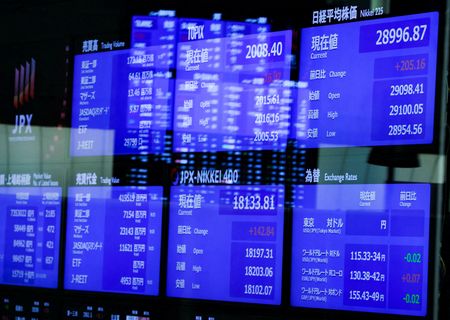
By Lawrence Delevingne and Amanda Cooper
(Reuters) -Wall Street and global shares rebounded on Monday on positive economic data, but were still near six-week lows as investors remained nervous that they should prepare for higher interest rates in the United States and Europe.
U.S. core capital goods orders accelerated in January, beating forecasts, according to government figures released on Monday. A raft of euro zone inflation figures will also shape investor expectations for next month’s central bank meetings.
At least six Federal Reserve policy makers are set to speak this week, potentially giving clues on potential rate hikes amid a confounding mix of economic signals.
On Monday morning The Dow Jones Industrial Average rose 0.69%, to 33,042.65, the S&P 500 gained 0.79%, to 4,001.48 and the Nasdaq Composite added 1.05%, to 11,514.60.
The MSCI All-World index of global shares was up 0.7%, after dropping 2.6% last week, its largest weekly decline since late September thanks to a sizzling rally in the dollar.
The index is heading for a 3% decline in February, after a rally in January saw many major stock indices post their strongest performance for the first month of the year in years.
“With the equity market showing signs of exhaustion after the last Fed meeting, the S&P 500 is at critical technical support,” Morgan Stanley U.S. equity analysts wrote in a note on Monday. “Given our view on earnings, March is a high risk month for the bear market to resume.”
January’s euphoria, which was founded on expectations that the major economies will avoid tumbling into recession this year, has given way to something approaching realism about the outlook for interest rates, which are going to rise by more and stay at those levels for longer than many had previously anticipated.
“Fed speak this week…will emphasize the need for more rate hikes, as per usual by now,” TD Securities strategists wrote in a note on Monday. If economic data for February is as strong as it was in January, “some officials might signal upside risk to their rate outlook,” they added.
Fed futures now have rates peaking at around 5.4%, implying at least three more hikes from the current 4.50% to 4.75% band, and some chance of 50 basis points in March.
When the Fed concluded its last policy meeting in early February, prior to the release of bumper January employment and business-sector activity data, markets showed traders expected a peak rate of 4.73%, meaning that there’s almost an extra three-quarters of a point now priced in.
U.S. two-year Treasury yields, the most sensitive to shifts in interest-rate expectations, have risen by almost 80 bps in that time, while the S&P 500 has lost 6% in value from Feb. 2’s five-month highs.
On Monday, the two-year U.S. Treasury yield fell 2 basis points to 4.785%, while 10-year Treasury yields dropped 3.9 basis points to 3.910%.
STOCKS RECOUP SOME LOSSES
European stocks bounced back on Monday, as typically rate-sensitive sectors such as oil and gas and technology picked up after falling sharply last week by 1.4% and 3.8% respectively.
The STOXX 600, which last week lost 1.4%, was up about 1.3%.
Economists at UK banks Barclays and Natwest both said they believe the Fed could raise rates by as much as half a percentage point in March, well above the quarter-point that markets currently price in.
It’s not just the United States where investors believe the central bank will have to keep raising rates to bring inflation back down. Money markets show traders believe the European Central Bank and the Bank of England will have to lift rates to a higher peak and leave them there for longer.
Bruce Kasman, head of economic research at JPMorgan, has added another quarter-point hike to the ECB outlook, taking it to 100 basis points. Germany’s 2-year bond yield broke above 3.0% on Friday for the first time since 2008.
“The risk is clearly skewed toward greater action from the Fed,” says Kasman.
The dollar has been the main beneficiary of the shift in expectations for Fed rates.
It has risen by 3% this month against a basket of major currencies, which would mark its strongest monthly performance since September, when it hit 20-year highs.
The dollar was last down 0.3% on the day, pushed in part by gains in the pound, which was last up 0.7% amid renewed speculation Britain and the European Union will finalise a Northern Ireland deal, which could resolve post-Brexit tensions.
Oil prices edged lower on Monday as the dollar’s recent strength discouraged buying, though losses were limited by supply concerns after Russia halted exports to Poland via a key pipeline. U.S. crude fell 0.5% to $75.94 per barrel and Brent was at $82.72, down 0.53% on the day.
Spot gold added 0.2% to $1,814.10 an ounce.
(Reporting by Lawrence Delevingne in Boston and Amanda Cooper in London. Additional reporting by Wayne Cole in Sydney; Editing by Susan Fenton)

